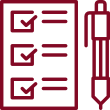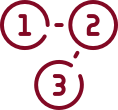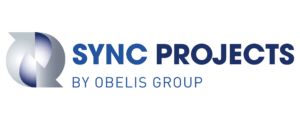The implementation of the ISO 9001 standard begins with a survey and understanding of the environment in which the organization operates and the work processes by which it operates.
Easily pass the ISO 9001 certification:


We define the work methods according to which the organization acts, in a clear, understandable language for all its employees and in accordance with the requirements of the Standard.

"Aligning" the work processes that employees are familiar with, in combination with a reference to the quality processes that will be integrated into the organization's activities.

Final preparations for the certification assessment and a review of the defined completions and gaps in order to comply with the requirements of the Standard.

A surveyor from the Certification Institute will arrive and will review the organization's quality management system. After the organization meets the requirements, it will receive the Certificate according to the ISO 9001: 2015 Standard.
The ISO 9001:2015 Standard - Quality Management Standard
What is "Quality Management"? Regulated work processes according to which organizations work. The certification process for ISO 9001: 2015 can be executed in a simple and easy procedure, and suiting to your needs.
In order to simplify the process, we show the stages for a proper implementation of the Standard.
(You might be interested to read Blog ISO Standards)
The ISO 9001 Standard is considered the "Father of all Standards" and is a comprehensive framework for a series of specific quality standards in many industries and organizations.
The Standard was determined by the International Organization for Standardization and is reassessed and updated every few years. The Standard's main purpose: Ensure that the organization's products and services meet the customers' quality requirements – and even beyond.
At SYNC Projects we gathered extensive practical experience in assisting hundreds of companies and organizations to obtain this Quality Standard Certification.
The ISO 9001 Standard is based on several principals of quality management:
- Customer Focus. The organization must understand the customer's needs and his expectations from the service or the product. The processes in the organization must give a full response to these needs, and strive to provide beyond the expected
- Management as Leadership. The management is responsible for formulating a clear, consistent, and binding quality policy. The management is committed to comply with this policy in its actions and perform periodic inspections to verify the implementation in the organization.
- Process Approach and System Approach. Optimizing the output of different and parallel processes that take place in an organization (for instance, in different departments), synchronization of processes and establishing reciprocal relations between the processes in order to improve efficiency in the organization and to obtain effective results according to the organization's objectives.
- The Human Resource. Ongoing development of the organization's human resource, through a systematic training system. Connecting employees to processes and tasks in a way that makes them feel part of the organizational effort.
- Continuous improvement. Systematic measuring of the organizational processes, analyzing the results, understanding and drawing conclusions for improvement and optimization. Measurement and improvement processes should be part of all of the organization's activities.
- Decision Making. The decisions of the organization's management are based on the understanding of up to date data and their logical analysis.
- Relationship with suppliers. Establishing a relationship based on mutual benefit for all parties
The ISO 9001:2015 Standard is the Quality Standard's latest revision and is valid as from September 2015. The first version of the ISO 9001 standard was published in 1987. Currently about one million organizations in 170 countries have implemented the Standard. Billions of consumers around the world recognize the Standard as a binding global stamp, and see it as a quality symbol for the product or service.
 Medical Device
Medical Device Cosmetics
Cosmetics ISO Standards
ISO Standards


